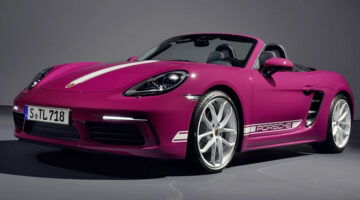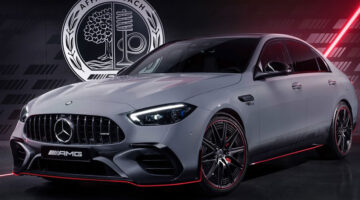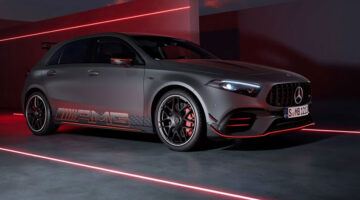Compared with the Porsche a few moments earlier, there’s a big difference on the inside. Whilst the Cayenne finds a good balance between ride comfort and handling, Mercedes has gone all out for that sporty feeling, the lowered suspension and stiffer chassis over the 63’s ML base model providing a surprisingly low driving position, but at the same time ride comfort that is perhaps a little too stiff: Steve, having fallen out of the Mercedes moments earlier feels somewhat relieved to have now taken up position in the Porsche behind Arun and I.
The 5.5-litre twin-turbocharged V8 under the bonnet – the most powerful of the three at 518bhp – begins to growls its raw power as we climb further into the twisting ribbon of tarmac, though admittedly the Porsche’s 500bhp 4.8-litre biturbo V8 is hardly dawdling behind us.
The punch of both off the line is quite remarkable (the Merc just nailing it with that additional 18bhp), the launch accompanied by an aggressive basey soundtrack and acceleration that doesn’t even think of waning until we’ll well on our way to the redline. The big difference in performance though between the ML63 and the Cayenne comes down to the gearbox, and that stiffened ride. In the past I’ve made mention of the AMG seven-speed’s tendancy to nanny in its efforts to protect the transmission from over-revving. Admirable and clever certainly, but the AMG system’s tendency to hold a gear rather than letting the driver change down entering some of the tighter turns can upset the balance, and any momentum you’ve picked up.

Oh there’s plenty of grip from those front tyres and the weighty(ish) steering does mean you’ll know exactly where you’re pointing the front end, but the inability to change down as and when you want to means the stopping power of those AMG-spec brake discs are going to be put to the test quite regularly. The weight of the Merc also adds its problems, the bulk landing on the ML63’s nose through many of the tighter corners, bringing understeer with it when the beans are really being given. The sheer grunt of the 518bhp V8 means that on the straights immediately out of the corners, the Range Rover and Porsche have no chance of keeping up, but through the corners, they’re breathing down the ML’s neck.
Steve in the Porsche following close behind proves as much, the Cayenne Turbo getting bigger in my rear view mirror into the tighter corners. Thanks to a much lower centre of gravity, it’s easy to see that sporty Porsche heritage in the Cayenne, the Turbo proving surprisingly nimble through the corners. Good weight distribution also helps offset any traces of understeer, allowing Steve to get the power down earlier out of the corners than I am managing to do in the Merc (of course almost a full year under the Nissan GT Academy umbrella is a help for Steve too). Mercifully there’s plenty of heft at the wheel too, allowing Steve to place the Cayenne’s front wheels where he wants them. The angry AMG may have the legs out of the corners, but there’s still plenty of grunt in the 500bhp twin-turbo V8 to offer linear acceleration and a reinvigorated oomph at mid rev-range. There’s not a doubt in my mind that were Steve not holding station, the Cayenne would be passed and well on its way down the mountain by now.
Several stretches of photogenic mountainscape bring our hoon to a brief end whilst we set up the camera equipment. It’s also the perfect opportunity for us to make the final switch, with the Cayenne taking up camera car duties with John and Cedrick, Steve taking the bad-boy Mercedes under his wing, and I finally getting some time with our eponymous hero, the Range Rover Sport.

Ironically our ‘man with no name’ boasts the greatest pedigree of the three, courtesy of the Range Rover’s four-generation, 44-year history as opposed to the ML’s debut in 1997 and the Cayenne’s first appearance in 2002. Almost immediately though the sensation in the Sport – which crankandpiston drove on the international launch in the UK – is much ‘SUV’ier than ‘sporty’ as opposed to our other two contenders. My seating position for instance is much higher, as is the comparative centre of gravity, and my enthusiasm to throw the Sport at the winding tarmac is slightly dampened as a result. There’s also more focus on low range four-wheel drive and hill descent controls than either the Mercedes or Porsche, emphasising exactly how the Range Rover made its name.
As the turns become yet tighter, the balance of ‘SUV’ to ‘Sport’ begins to shift. Compared with the Porsche and the Mercedes for instance, there is much less tinsel in the cabin, the key components being a touchscreen infotainment system, climate control rotary dials and a more minimalist centre console: I even have an armrest (and THOSE plastic paddle shifters). It’s all so minimalist yet comfortable – thanks to a silky smooth ride and good acoustics – that the ‘look at me’ visage of the Mercedes and the overly complicated nature inside the Porsche cannot meet: with a stretch of winding tarmac, the focus is simply on driving. So that’s what we do.
For an SUV measuring more than six-feet tall, the Sport is remarkably nimble thanks to a considerably lower base weight over its predecessor. Obviously some bodyroll kicks through the tighter turns, but there’s little understeer quite unusually. With more boosted confidence, the speedometer needle begins to rise, corners are taken more aggressively thanks to weighty steering and a good sense of balance: even throwing the brakes on hard into the corners doesn’t upset the remarkable nimbleness of the Sport through the turns. Under the grooved bonnet of the Sport lies a 510bhp 5.0-litre supercharged V8, delivering more power in the lower revs than its turbo-charged rivals, keeping me glued to the back of the Mercedes and the Porsche as we feed the power back in out of the corners. Even at the top, there’s little sense of overexertion by the V8 and no lag. Push the Range Rover Sport – an SUV – and it obeys.

The sun is beginning to set just above the mountain range, and for our final shots, the three contenders have formed a triangle, one LED headlight eying another. So, which has drawn first in this three-way duel? Which will ride into the horizon, and which ends the day with its head in a noose?
As far as poise goes, the Cayenne tops our trio, five decades of 911 heritage having been developed into the design well, likewise good weight distribution and a stiffened chassis for better handling albeit not at the expense of the ride. And yet, the Cayenne doesn’t come out on top. So far I’ve been focusing on the sportiness of our three models, and it’s only as we begin to creep further off road that the pedigree of each model becomes more relevant. And therein ultimately lies the Mercedes and the Cayenne’s Achilles heel. With low ground clearance and porky kerb weights, it’s as we manoeuvre the ML63 and the Cayenne that we take the most care: should one of them ground or get stuck, it’s going to take some time to get them out. There’s no such qualms with the Range Rover, however: of the three, it’s the model all of us want to be driving across country.
It’s not just the effectiveness of the Range Rover off-road that has won us over either. Yes, with it’s brash looks, the Mercedes is undoubtedly the most distinctive, while the Porsche’s poise means it’s the one we’d all choose to take for a mountain-road thrash. For the Range Rover it’s a different story. It’s elegant, functional, easy-to-use and great for soaking up the kilometres. On road or off, it takes the terrain with aplomb – on the limit or otherwise – without the feeling that’s it’s over-reaching. As an all-rounder, it tops both the Porsche Cayenne Turbo and the Mercedes-Benz ML63 AMG. And as a sporty SUV, that’s what we’re all looking for.

In 1966, Clint Eastwood galloped into the distance as the famous soundtrack began to play. Today, as the Middle Eastern sun begins to set over our sporty SUVs, Good has triumphed once again.
That’s your cue to start whistling…
– FULL GALLERY OF SHOTS AVAILABLE HERE – CLICK –
Downloadable wallpapers HERE – SET 1
Downloadable wallpapers HERE – SET 2
FULL TECHNICAL SPECIFICATIONS AVAILABLE on page 3



